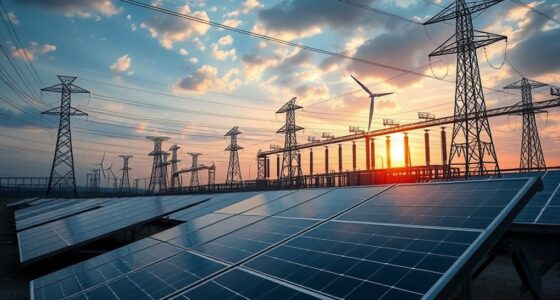Solar power works by converting sunlight directly into electricity through photovoltaic cells. When sunlight hits these cells, it excites electrons, creating an electric current. Different types of cells, like monocrystalline, polycrystalline, or thin-film, offer varying efficiencies and performance conditions. Your choice depends on your space, budget, and climate. Learning about the specifics can help you maximize your solar system’s output — explore further to understand how different panels perform in diverse environments.
Key Takeaways
- Photovoltaic cells convert sunlight into electricity through the photovoltaic effect, exciting electrons within the material.
- Different cell types (monocrystalline, polycrystalline, thin-film) vary in efficiency and suitability for specific needs.
- Higher efficiency panels generate more power in limited space, especially in challenging environmental conditions.
- Temperature and light conditions influence how well photovoltaic cells perform, affecting overall energy output.
- Selecting the right solar panel type based on needs maximizes energy production and system effectiveness.

Have you ever wondered how sunlight can turn into electricity? It’s a fascinating process, and understanding it begins with knowing how solar panels capture and convert sunlight. Solar panel efficiency plays a key role here, determining how much sunlight a panel can turn into usable electricity. The higher the efficiency, the more power you get from a smaller or less-than-ideal space. This efficiency depends largely on the type of photovoltaic cells used within the panel. There are several photovoltaic cell types, each with its own strengths and limitations. Monocrystalline cells are known for their high efficiency, often reaching around 20% or more, making them a popular choice for those who want maximum output in limited space. Polycrystalline cells, on the other hand, are slightly less efficient—typically 15-17%—but tend to be more affordable and easier to produce. Then there are thin-film cells, which are less efficient overall, usually around 10-13%, but they are lightweight and flexible, making them suitable for specific applications where weight and flexibility matter more than maximum efficiency.
When sunlight hits a photovoltaic cell, it excites electrons, creating an electric current. This process is called the photovoltaic effect. The more efficient the cell, the more electrons it can generate from the same amount of sunlight. This is why the type of photovoltaic cell matters so much; it directly influences the panel’s overall efficiency. The design and material of these cells also determine how well they perform in different conditions, such as high temperatures or low light, further affecting their efficiency ratings. For example, monocrystalline cells tend to perform better in hot climates, maintaining higher efficiency levels than other types.
Your choice of solar panel should depend on your specific needs, available space, and budget. If you have limited space and want maximum output, investing in high-efficiency monocrystalline panels makes sense. If you’re looking for a more budget-friendly option and have plenty of space, polycrystalline panels might work just fine. Thin-film panels are best suited for flexible applications or where weight is a concern, even if they sacrifice some efficiency. The key is understanding how photovoltaic cell types impact solar panel efficiency and how that, in turn, affects your overall energy production. By choosing the right panel type, you can optimize your solar power system to meet your energy needs efficiently and cost-effectively.
Frequently Asked Questions
Can Solar Panels Work During Cloudy or Rainy Days?
Yes, your solar panels can work during cloudy or rainy days, but their efficiency drops. Cloudy conditions reduce solar energy, so your panels won’t produce as much power, impacting cloudy efficiency. Rain can wash away dirt and dust, improving performance temporarily, but heavy rain or persistent clouds limit energy generation overall. You’ll still get some power on cloudy or rainy days, just less than on sunny days.
How Long Do Solar Panels Typically Last Before Needing Replacement?
Your solar panels typically last around 25 to 30 years before needing replacement. Over time, panel degradation causes a gradual decrease in efficiency, but most panels still produce some power well beyond their warranty coverage. Regular maintenance helps extend their lifespan, and warranty coverage usually protects against significant issues. Keep an eye on performance and consult your installer if you notice a sharp decline in energy output.
What Are the Environmental Impacts of Manufacturing Solar Panels?
Manufacturing solar panels does have environmental impacts, mainly from manufacturing emissions released during production. These emissions can contribute to air pollution and greenhouse gases. Additionally, recycling challenges arise because old panels contain hazardous materials like heavy metals, making disposal difficult. However, despite these issues, solar energy still offers a cleaner alternative to fossil fuels, and ongoing advancements aim to reduce manufacturing impacts and improve recycling methods.
Is Solar Power Cost-Effective for Small-Scale Residential Use?
Yes, solar power is cost-effective for small-scale residential use. You can achieve significant cost savings on your energy bills over time, which helps offset installation expenses. Although upfront costs might seem high, incentives and decreasing equipment prices make solar panels more affordable. Once installed, you benefit from clean, renewable energy, reducing your environmental impact while enjoying long-term savings on electricity costs.
How Does Shading Affect the Efficiency of Photovoltaic Systems?
Imagine your solar panels as a team of runners. When shade falls on them, it’s like a runner getting a sprinter’s start blocked — the shading impact causes efficiency reduction. This means your system produces less power, as the shaded cells can’t contribute fully. Even a small shadow can considerably decrease overall performance, so keeping panels clear of shade maximizes energy output and maintains peak efficiency.
Conclusion
Now that you understand how photovoltaics convert sunlight into electricity, you’ll appreciate the power behind solar panels. Did you know that a single hour of sunlight could generate enough energy to meet the world’s electricity needs for a year? With solar power becoming more accessible and affordable, you can play a part in reducing carbon emissions. Embrace this renewable energy source and help build a cleaner, greener future for everyone.










